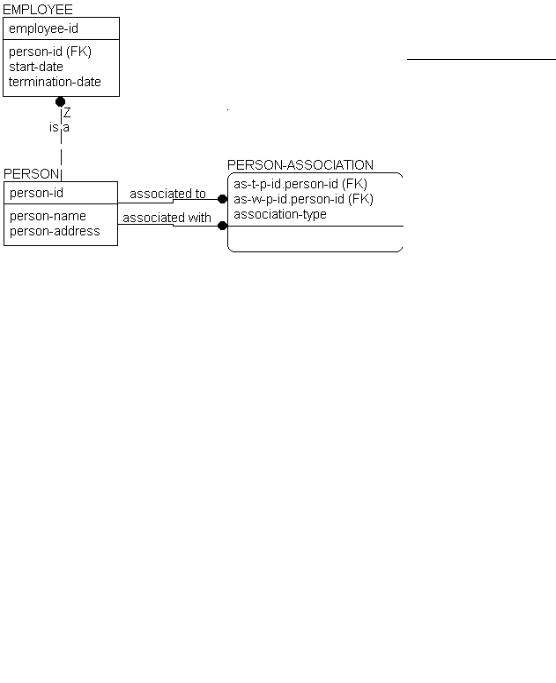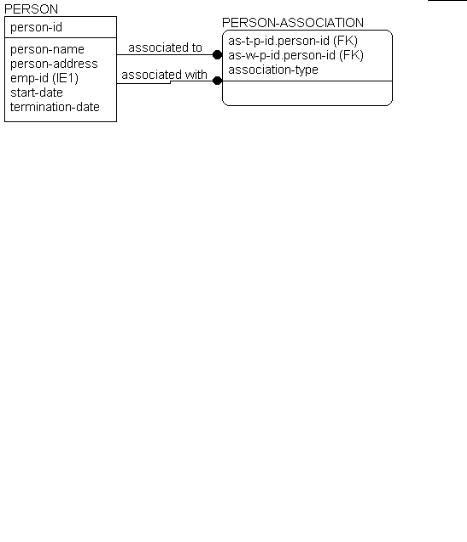
- •Contents
- •Preface
- •Intended Audience
- •About this Guide
- •Typographical Conventions
- •Related Documentation
- •What’s In This Chapter?
- •Chapter Contents
- •What is Data Modeling?
- •Data Modeling Sessions
- •Session Roles
- •Sample IDEF1X Modeling Methodology
- •Logical Models
- •The Entity Relationship Diagram
- •The Key-Based Model
- •The Fully-Attributed (FA) Model
- •Physical Models
- •The Transformation Model
- •The DBMS Model
- •Benefits of Modeling in ERwin
- •What’s In This Chapter?
- •Chapter Contents
- •The Entity-Relationship Diagram
- •Defining Entities and Attributes
- •Logical Relationships
- •Many-to-Many Relationships
- •Validating the Design of the Logical Model
- •Data Model Example
- •What’s In This Chapter?
- •Chapter Contents
- •Understanding Keys
- •Selecting a Primary Key
- •Designating Alternate Key Attributes
- •Inversion Entry Attributes
- •Relationships and Foreign Key Attributes
- •Dependent and Independent Entities
- •Identifying Relationships
- •Non-Identifying Relationships
- •Rolenames
- •What’s In This Chapter?
- •Chapter Contents
- •Naming Entities and Attributes
- •Synonyms, Homonyms and Aliases
- •Entity Definitions
- •Descriptions
- •Business Examples
- •Comments
- •Definition References and Circularity
- •Constructing a Business Glossary
- •Attribute Definitions
- •Rolenames
- •Definitions and Business Rules
- •What’s In This Chapter?
- •Chapter Contents
- •Relationship Cardinality
- •Cardinality in Non-Identifying Relationships
- •Referential Integrity
- •Reading Referential Integrity Options
- •RI, Cardinality, and Identifying Relationships
- •RI, Cardinality, and Non-Identifying Relationships
- •Additional Relationship Types
- •Many-to-Many Relationships
- •N-ary Relationships
- •Recursive Relationships
- •Subtype Relationships
- •Complete Versus Incomplete Subtype Structures
- •Inclusive and Exclusive Relationships
- •IDEF1X and IE Subtype Notation
- •When to Create a Subtype Relationship
- •Introduction
- •Chapter Contents
- •Overview of the Normal Forms
- •Functional Dependence (FD)
- •Full Functional Dependence
- •First Normal Form (1NF)
- •Second Normal Form (2NF)
- •Third Normal Form (3NF)
- •Common Design Problems
- •Repeating Data Groups
- •Multiple Use of the Same Attribute
- •Multiple Occurrences of the Same Fact
- •Conflicting Facts
- •Derived Attributes
- •Missing Information
- •Unification
- •How Much Normalization Is Enough?
- •Conclusions
- •ERwin Support for Normalization
- •First Normal Form Support
- •Second and Third Normal Form Support
- •What’s In This Chapter?
- •Chapter Contents
- •Creating a Physical Model
- •Denormalization
- •Classification of Dependent Entities
- •Glossary of Terms
- •Index
- •Documentation Comments Form

6 |
ERwin Methods Guide |
|
|
How Much Normalization Is Enough?
From a formal normalization perspective (what an algorithm would find solely from the “shape” of the model, without understanding the meanings of the entities and attributes) there is nothing wrong with the EMPLOYEE- CHILD-SPOUSE model. But just because it is normalized does not mean that the model is complete or correct. It still may not be able to store all of the information that is needed, or may store it inefficiently. With experience, you can learn to detect and remove additional design flaws even after the “pure normalization” is finished.
In the earlier EMPLOYEE-CHILD-SPOUSE model example, you have already discovered that there is no way of recording a CHILD whose parents are both EMPLOYEEs. So you can make additional changes to try to accommodate this type of data.
If you noticed that EMPLOYEE, SPOUSE, and CHILD all represent instances of people, you may want to try to combine the information into a single table that represents facts about people and one that represents facts about relationships. To fix the model, you can eliminate CHILD and SPOUSE, replacing them with PERSON and PERSON-ASSOCIATION. This lets you record parentage and marriage through the relationships between two PERSONs captured in the PERSON-ASSOCIATION entity.
EMPLOYEE, PERSON, and PERSON-ASSOCIATION Entities
86 ∙ Normalization

ERwin Methods Guide |
6 |
|
|
In this structure, we can finally record any number of relationships between two PERSONs, as well as a number of relationships we could not record before. For example, the previous model had not considered “adoption.” The new structure, however, automatically covers it. To represent “adoption” you can add a new value to the “person-association-type” validation rule to represent adopted parentage. You can also add “legal guardian,” “significant other,” or other relationships between two PERSONs later, if needed.
EMPLOYEE remains an independent entity, because the business chooses to identify EMPLOYEEs differently from PERSONs. However, EMPLOYEE inherits the properties of PERSON by virtue of the “is a” relationship back to PERSON. Notice the “Z” on that relationship and the absence of a diamond. This is a one-to-zero or one relationship that can sometimes be used in place of a subtype when the subtype entities require different keys. In our example, a PERSON either “is an” EMPLOYEE or not.
If we had wanted to use the same key for both PERSON and EMPLOYEE we could have “encased” the EMPLOYEE entity into PERSON and allowed its attributes to be NULL whenever the PERSON was not an EMPLOYEE. We still could have specified that the business wanted to look up “employees” by a separate identifier, but the business statements would have been a bit different. This structure is shown below.
Generalized Employee Model Construct
Conclusions
What this all basically comes down to in the end is that a model may “normalize,” but may still not be a correct representation of the business. Formal normalization is important. Verifying, perhaps with sets of sample instance tables as we have done here, that the model means something is no less important.
Normalization ∙ 87
